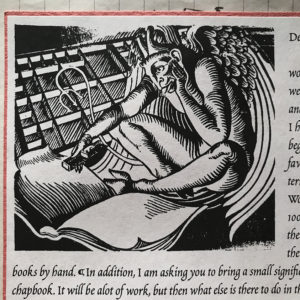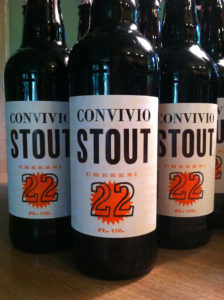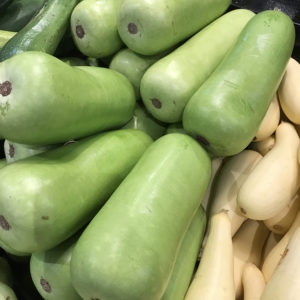
Summer is quickly waning. It’s still plenty hot here in Lake Worth (and it will be for weeks to come) but the kids are back in school for a couple of weeks now, and that is the surest sign that summer is near to ending. Another sure sign: the sun is setting much earlier now than it was just a month ago. The longest day that came at St. John’s Day in June is long past as we inch closer and closer to the balance of day and night that comes with the equinox of September. And today we have a reminder of this, steeped in tradition: It is St. Bartholomew’s Day––Bartlemas, a day celebrated less in churches so much as it is amongst practitioners of the Book Arts: papermaking, bookbinding, and most especially the one that is sometimes referred to as the Black Art: printing (more on that Black Art thing later). St. Bartholomew is a patron saint of all these noble professions (Post print addendum: actually, he is a patron saint only of bookbinders. See the next chapter, Here We Do Not Speak Evil of Anyone, for the clarification and my apology), and his feast day on the 24th of August brings the Bartlemas Wayzgoose, a particularly English celebration that comes out of this shifting of the seasons.
We know very little about the historical St. Bartholomew. He was one of the Twelve Disciples; that much we do know. He may have traveled to India, to the area around Bombay. Tradition says that he met his end in Armenia in the first century. His martyrdom was a gruesome one––one that by association made St. Bartholomew a patron saint of butchers and of tanners and of bookbinders, who very often bind books in leather. I’ll leave the method of his martyrdom, based on those associations, to your imagination, but there, nonetheless, is our connexion to the bookbinders.
For papermakers, the connexion goes back to the days before glazed glass windows. Back then, it was waxed paper that was used to keep out the elements, and the arrival of Bartlemas was the signal that it was time to paper the windows in preparation for winter. Once this St. Bart’s window paper was made, the papermakers went back to making paper for the printers, clearing out the vats and recharging them with new pulp made from rags that had been retting all summer long.
And now the printers: Bartlemas, being a full eight weeks past the summer solstice, brought with it each year a certain reality: Sunlight, like summer, is waning, and the days are growing darker and darker. Along with the papering of the windows came the necessity of illuminating the print shop with lanterns and candles. A good print shop proprietor would make a celebration of the day. Randall Holme, in 1688, gave us this description of the Bartlemas Wayzgoose: “It is customary for all journeymen to make every year, new paper windows about Bartholomew-tide, at which time the master printer makes them a feast called a Wayzgoose, to which is invited the corrector, founder, smith, ink-maker, &c. who all open their purses and give to the workmen to spend in the tavern or ale-house after the feast. From which time they begin to work by candle light.”
To be sure, there was a good quantity of ale consumed as part of the Wayzgoose. In some places, mead, the delightful intoxicating beverage made from honey, was the beverage of choice. Especially in Cornwall, where a Blessing of the Mead ceremony takes place even today at this time of year. Continuing the road of connexions, our friend St. Bartholomew is also a patron saint of beekeepers, and as we continue to gather our stores for the coming winter, it is traditional, too, to bring in the honey crop on his feast day.
It was on August 27, 2010, that the Jerusalem Post reported that Johannes Gutenberg’s 42-Line Bible, the first book printed from moveable type, was completed on St. Bartholomew’s Day in 1454. I try every now and then to find other sources to back up this claim, but I have to date had no luck. Still, I like the idea of this and if it is indeed true, this may have something to do with the day becoming a matter of such importance to printers and bookbinders and papermakers. Some say, too, that that first printed book explains why printing has a history of being called the Black Art. They claim that Johannes Fust, Gutenberg’s business partner, sold several of the printed bibles in France without explaining how they were made. When it was discovered that the books were identical copies of each other, Fust was accused of witchcraft and was briefly imprisoned for that crime. It was a different world back then, with information spread by rumors. It was the printing press, though, that ushered in an age of knowledge and literacy and enlightenment. Some would say, too, that we have reverted back to those medieval ways: there are those who claim time and time again that the printed word is not to be trusted, calling trusted information sources “fake news,” feeding us their own brand of information through social media, the 21st century equivalent of medieval rumor. 564 years after Gutenberg, we find ourselves suddenly no better than Johannes Fust’s accusers.
One thing is certain: if you are a book artist or if you are a book enthusiast, this is a very auspicious day for you. For this Bartlemas Wayzgoose, then, perhaps we have cause to celebrate the book and the people who make books: the papermakers, the printers, the bookbinders, the book artists. This Bartlemas, let us raise our glasses to St. Bart and to all of these good artisans… and to celebrate the printed word and make a pledge to value its importance to good living and to good citizenship. The printer’s devil and his Black Art might just be more important than we think.
Image: On the approach to my very first book arts class, which was at the Penland School of Crafts in July, 1994, I received a postcard in the mail from the instructor, Steve Miller. His class was my introduction to printing and the book arts, and I had a good feeling about it from the time I beheld that postcard with its illustration of a printer’s devil setting type in a composing stick. Now, these are the tools of my trade. Its ties wend back through time, back to the Mainz workshop of Fust & Gutenberg.
Won’t you join me at our own local Wayzgoose? It’s the Library Wayzgoose Festival and it’s happening tomorrow, Saturday August 25, from 10:30 AM to 5:30 PM, at the Jaffe Center for Book Arts and throughout the east third floor wing of Florida Atlantic University’s Wimberly Library in Boca Raton. Admission is free. You’ll find activist printer Ben Blount there from Illinois, offering print demos all day in the print shop and a gallery talk at 3 in the Book Arts Gallery. You’ll get to make your own traditional paper printer’s cap. The League of Women Voters will be there, ready to register voters. There’ll be live music from Humble Waters early in the day and later, from Ella Herrera. There’ll be a bevy of local makers showing and selling their wares at the Wayzgoose Makers Marketplace. And lots more. Rain or shine, inside the library, we’ll be kicking up some fun and honoring that Wayzgoose spirit all day. Come to the Convivio Bookworks booth and say hello. We can wish each other a Happy Bartlemas, you in your paper printer’s cap, me in mine.



